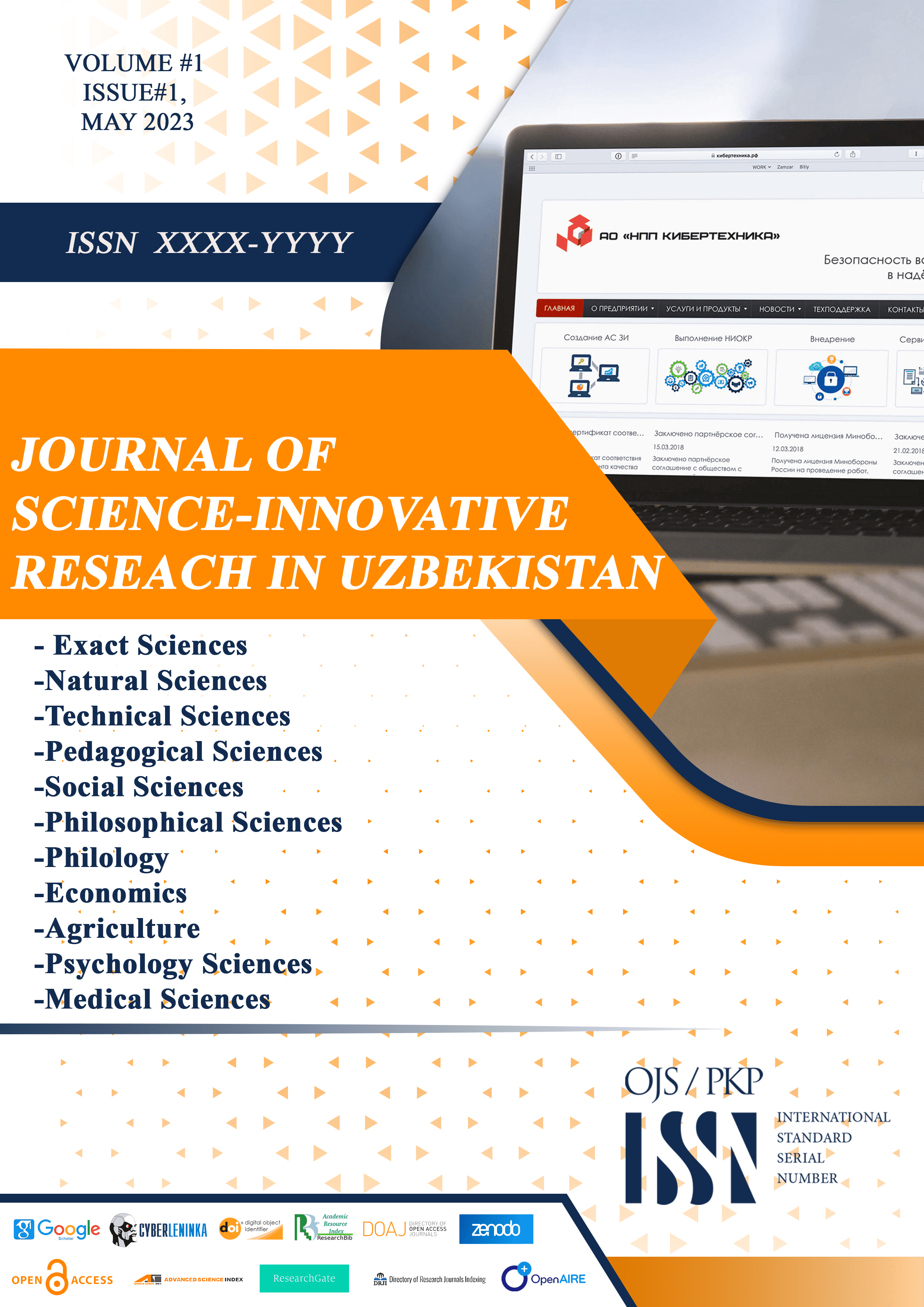Abstract
The English language, due to its role in the world today, has become the cornerstone of higher education development. One’s ability to speak specific English to his domain is a good asset required by job market and scientific research. Knowledge of English language enables us to participate in various international medical conferences, after which we can cooperate with international colleagues in the field of health care.
References
1. Ilhomjonovna, S. K., & Parvina, O. (2020). Structural-Morphological Characteristics of Binary Tautologisms. International Journal on Orange Technologies, 2(12), 23-28.
2. Dilbar, I., & Kamola, S. (2022). Teaching English methods. Thematics Journal of Education, 7(5).
3. Shamsiyev, K., Olimzoda, P., Saidova, K., & Ibragimova, D. (2023, February). Approaches to Teaching Academic Writing. In Международная конференция академических наук (Vol. 2, No. 2, pp. 31-34).
4. Saidova, K., Ibragimova, D., Olimzoda, P., & Shamsiyev, K. (2023). INFLUENCE OF USING GAMES ON ENGLISH LESSONS. Theoretical aspects in the formation of pedagogical sciences, 2(4), 54-58.
5. Shodikulova, A. Z. (2021). Methodology For Using Computer Training Programs In English Lessons. Turkish Journal of Computer and Mathematics Education (TURCOMAT), 12(13), 3358-3367.
6. Kakhramon, S., Dilbar, I., & Kamola, S. (2023). Terminology as a special branch of language. Journal of new century innovations, 22(4), 46-49.
7. Saidova, K. (2024, May). USING GAMES ON ENGLISH LESSONS IN HIGHER EDUCATION INSTITUTES. In Conference Proceedings: Fostering Your Research Spirit (pp. 142-144).
8. Ananyev B.G. Psixologiya pedagogicheskoy osenki // Izbrannyye psychologicheskiye trudy. T .: 2. –M .: 1980.
9. Akhmedova M. Theory and history of pedagogy. Textbook.-T .: “Tafakkur
bostoni”, 2011.157-p.
10. Ибрагимова , Д. 2024. Зеленые богатства Узбекистана и их полезные лечебные свойства. Общество и инновации. 5, 3/S (мар. 2024), 121–124.
11. Sadullayevna, I. D. (2024). COLLABORATION IN TEACHING ENGLISH FOR SPECIFIC PURPOSES. Central Asian Journal of Multidisciplinary Research and Management Studies, 1(8), 80-83.
12. Ibragimova, D., & Mukhammadieva, M. (2024, May). MOTIVATING TECHNIQUES FOR LEARNING FOREIGN LANGUAGES. In Conference Proceedings: Fostering Your Research Spirit (pp. 54-56).
13. Kakhramon, S., Dilbar, I., & Kamola, S. (2023). Terminology as a special branch of language. Journal of new century innovations, 22(4), 46-49.
14.Yaxyayevna, N. S. (2023). FONOLOGIYA VA UNING TURLARI.". XXI ASRDA INNOVATSION TEXNOLOGIYALAR, FAN VA TAʼLIM TARAQQIYOTIDAGI DOLZARB MUAMMOLAR" nomli respublika ilmiy-amaliy konferensiyasi, 1(12), 5-9.
15.Nasimova, S. (2024). ONLINE TEACHING OF ENGLISH FOR MEDICAL PURPOSES. Центральноазиатский журнал междисциплинарных исследований и исследований в области управления, 1(8), 84-87.
16. Nasimova, S. Y. (2024, August). ANTROPONIM SARLAVHALAR. In Conference on Applied and Practical Sciences (pp. 149-151). Open Journal Systems.
17. Alisherovna, M. N. (2021). On the Comparative Study of Phraseology at the Present Stage. Central asian journal of mathematical theory and computer sciences, 2(9), 4-8.
18. Мавлонова, Н. (2019). Независимое возникновение межъязыковых фразеологических соответствий. Иностранная филология: язык, литература, образование, (4 (73)), 59-63.
19. Алишеровнамавлонова, Н. (2021). О сопоставительном изучении фразеологии на современном этапе. Scientific progress, 2(4), 849-856.
20. Мавлонова, Н. (2018). К вопросу о типологии фразеосочетаний. Иностранная филология: язык, литература, образование, 3(3 (68)), 71-73.
21. Мавлонова, Н. А. (2021). Теоретические основы исследования межъязыковой фразеологической общности. Jahon ilm-fani taraqqiyotida tarjimashunoslikning ahamiyati, 175.
22. Alisherovna, M. N., & Furqatovna, S. Y. (2022). Principles for Determining the Categories of Proximity of the Russian Language to Uzbek in the Field of Phraseology: Identification of Interlingual Phraseological Accordance. International Journal of Health Sciences, (V), 1414-1419.
23. Мавлонова, Н. (2024, May). МЕТОДЫ И ПРИНЦИПЫ СОПОCТАВИТЕЛЬНОЙ ФРАЗЕОЛОГИИ. In Conference Proceedings: Fostering Your Research Spirit (pp. 254-256).
24. Мавлонова, Н. (2024, May). ПРИНЦИПЫ РАЗМЕЩЕНИЯ ФРАЗЕОЛОГИЧЕСКИХ ЕДИНИЦ В СТАТЬЯХ РУССКО-ТЮРКСКИХ СЛОВАРЕЙ. In Conference Proceedings: Fostering Your Research Spirit (pp. 257-260).
25. Mavlonova, N., & Xolmurodova, N. (2024, May). ASSESSING PRIMARY LEVEL LEARNERS: STRATEGIES FOR EFFECTIVE KNOWLEDGE TESTING. In Conference Proceedings: Fostering Your Research Spirit (pp. 89-91).
26. Mavlonova, N. (2023). Interlanguage Phraseological Correspondence of English-Russian-Uzbek Languages and Their Classification. Journal of Language Pedagogy and Innovative Applied Linguistics, 1(4), 85-89.
27. Alisherovna, M. N. (2023). The Categories of Proximity of the Russian Language to Uzbek in the Field of Phraseology.
28. Alisherovna, M. N. (2020). Semantic and structural differences of paremias, maxims and sayings. Journal of Critical Reviews, 7(5), 680-681.
29. Норова, Х. И. (2018). ФОРМИРОВАНИЕ КЛЮЧЕВЫХ КОМПЕТЕНЦИЙ ОБУЧАЮЩИХСЯ НА УРОКАХ РУССКОГО ЯЗЫКА И ЛИТЕРАТУРЫ. ИСПОЛЬЗОВАНИЕ ИНФОРМАЦИОННО-КОММУНИКАЦИОННЫХ ТЕХНОЛОГИЙ В ПРЕПОДАВАНИИ МАТЕМАТИКИ ДЛЯ ОРГАНИЗАЦИИ ПРОФЕССИОНАЛЬНО-НАПРАВЛЕННОГО ОБУЧЕНИЯ, 188.
30. Мавлонова, Н. А. СМЕШАННЫЕ ГРУППЫ МЕЖЪЯЗЫКОВЫХ ФРАЗЕОЛОГИЧЕСКИХ СООТВЕТСТВИЙ. ILMIY AXBOROTNOMA, 31.
31. Мавлонова, Н. А. ПРИНЦИПЫ ОТБОРА И ОПИСАНИЯ ФРАЗЕОЛОГИЧЕСКИХ ЕДИНИЦ В СОВРЕМЕННЫХ РУССКО-ТЮРКСКИХ ФРАЗЕОЛОГИЧЕСКИХ СЛОВАРЯХ.
32. Мавлонова, Н. А., & Мавлонова, Н. А. ВНУТРИЯЗЫКОВАЯ И МЕЖЪЯЗЫКОВАЯ ИДИОМАТИЧНОСТЬ. BBC 94 Z 40, 59.

This work is licensed under a Creative Commons Attribution 4.0 International License.

